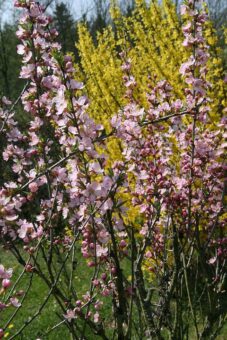In this article, we will discover how to grow the not so often seen Abeliophyllum in containers. It is not popular because it is often said to be an untidy plant, which is only sparsely covered with leaves. This is not a valid reason in my eyes and it will make a great change to the Forsythia often seen in gardens everywhere.

Abeliophyllum has the common name of miseonnamu, Korean Abeliophyllum, White Forsythia, or Korean abelialeaf. It is a member of the Oleaceae, the Olive family.
It has Korean in its common name should give a clue to where it originates from. It is an endangered plant in Korea where only 7 sites remain. As you can imagine, it is a relative to the Forsythia but instead produces white flowers. Abeliophyllum is a deciduous, slow-growing shrub that only grows up to 1m to 1.5m high. It is noted for growing multi-stemmed, arching branches. Like Forsythia, it produces white flowers that can be tinged pink in late winter in February and March.
The flowers also have the most delightful almond-like fragrance. As the flowers fade, winged-like fruits appear that look like elm tree fruits and then the long, simple green leaves appear in early spring.
You will need to go hunting but you should be able to find online suppliers.
Find out how to grow Abeliophyllum in containers in this article.
GROWING ABELIOPHYLLUM IN CONTAINERS
First, choose a container that is twice the size of the pot you bought from the shop. No matter what container you choose make sure it has plenty of drainage holes at the bottom. Add a 2cm layer of gravel to aid drainage further and on top of this, add a mix of 80% by volume of multipurpose compost with 20% by volume of perlite. Fill the container to within 5cm of the rim.
Dig a hole at the centre of the container slightly bigger than the root ball it came in the original container. Place the plant in so that the top of the root ball is at the same level as the top surface of the container. Backfill with the growing media so that no gaps remain, using more compost if necessary. Firm the plant in and water well.
GROWING CONDITIONS

For the plant to do well, you will need to place it in a sunny location. It will take a while for the plant to establish and until then you will need to water when 5cm below the top surface of the compost feels dry to the touch. Water the plant until it emerges from the drainage holes.
In early spring, you will need to fertilize once only with a slow-release fertilizer at the manufacturers’ recommended dosage.
Once flowering is over you can remove dead and damaged branches. You can remove about one-third of the mature growth of the old wood. This will not only keep the shrub compact but it will encourage the plant to flower better the following year.
To propagate it is best to take semi-ripe cuttings in summer and place them in a container in a cold frame or alternatively take heard cuttings and leave them in a sheltered spot in late autumn.
PESTS AND DISEASES
The good news is that the plant is not known to suffer from any known pests and diseases. The only problem you are likely to account is that frosts in winter may kill the blooms, spoiling the display. To avoid this, you can plant the shrub in a cold area where the late winter warm will not encourage the plant to bloom too early.
VARIETIES TO GROW

The only species in the genus is Abeliophyllum distinctum, which has been described in the introduction. The flowers are pale mauve at first, fading to pink and then white when mature. A noted variety is ‘Roseum’ which remains pink and does not turn white as it matures.
CONCLUSIONS
In this article, we have discussed how to grow the easy-to-care-for and look-after shrub of Abeliophyllum in containers. The plant makes a great alternative to Forthysia which is seen all over gardens in the UK. The flowers are a delight to look at and are scented and are produced in late winter, what more is to ask?
If you have any questions or comments that you wish to make about growing Abeliophyllum in containers, please do so in the comment box below.
Happy Abeliophyllum growing.
